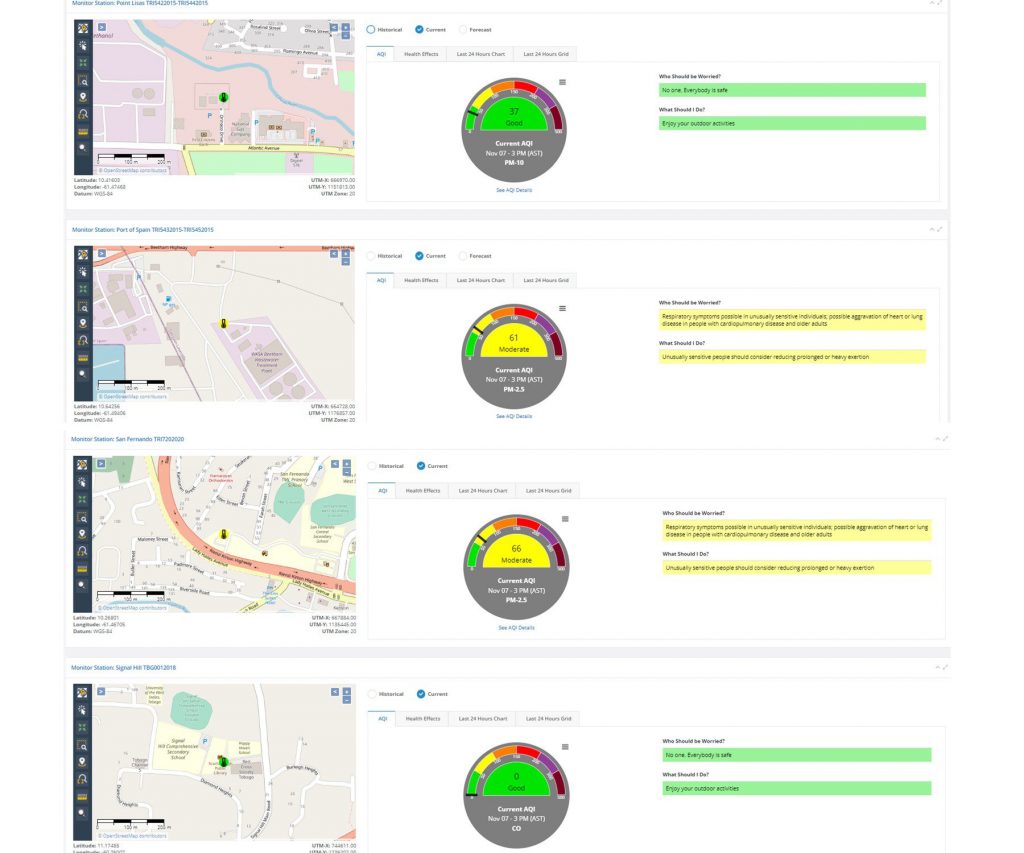Over the next four, the usual haze typically attributed to Saharan Dust will be mixed with volcanic gases (or Vog) from the Cumbre Vieja Volcano on the Canary Island of La Palma. This is forecast to affect both visibility and air quality across the country.
What is Vog?
Vog is a form of air pollution that results when sulphur dioxide (SO2) and other gases and particles emitted by an erupting volcano react with oxygen and moisture in the presence of sunlight. Typically, in a dense Saharan Dust surge, the sky can appear dull or tan. In contrast, sulfur oxides are colorless, and Vog looks grey. Once the vog layer dissipates, grey spots of Vog in the sky may, for a time, remain trapped in the inversion layer.
SO2 is a colorless, irritating gas that has an acrid odor like fireworks or a burning match. It is also emitted from sources such as fossil fuel power plants and motor vehicles.
Fine particles consist of particulate matter less than 2.5 micrometers in diameter and are referred to as ‘PM2.5‘. These particles are smaller than the width of human hair. PM2.5 in Vog is mainly composed of acid and neutral sulfate particles. Other sources of PM2.5 include vehicle exhaust and smoke from fires.
Vog contains mostly SO2 and acid particles, in contrast to urban, industrial, and other pollution sources, containing additional toxic contaminants, such as ozone and hydrocarbons.
Is Vog impacting air quality?
Dr. Erouscilla Joseph, the Director of the University of the West Indies Seismic Research Centre (UWI SRC), explained, “Vog from the eruption of Cumbre Vieja has been seen in satellite imagery, streaming towards Europe and across the Atlantic Ocean. Due to the extremely diffused levels at such large distances from the source, the levels are not harmful to health or the environment as they remain at [high] altitudes.“

The Environmental Management Agency (EMA) air quality monitoring stations recorded AQI values over the last 24 hours that are good to moderate across Trinidad and Tobago. These measurements are based on PM2.5 (particulates the size of 2.5 micrometers and smaller, usually associated with increases in Saharan Dust, vehicle exhaust, and smoke, and this rare case, also Vog) and PM10 particulates.
Because Vog and Saharan Dust particulates are impossible to differentiate at the PM2.5 and PM10 levels, we look to SO2 concentrations, which have remained at normal background levels. Visibility at Piarco and Crown Point remains above 10 kilometers at this time.
Could Cumbre Vieja’s Ash Make It To The Caribbean?
Dr. Joseph of the SRC explained, “Given the type of explosive activity generated by Cumbre Vieja Volcano, it is unlikely that any significant volcanic ash reaching the troposphere will be picked up by the Saharan Dust currently making its way across the region. Volcanic ash being trapped in the Sahara dust is likely to be minimal if at all detectable.”
She continued, “volcanic eruptions which generate eruption columns high enough to penetrate the troposphere (the lowest part of the earth’s atmosphere) may produce volcanic ash which can get caught in high air currents that allow them to circumnavigate the globe. Not all eruptions generate this kind of activity.”
When will the Vog & Saharan Dust move away?

A surge of dust and Vog is moving across the Lesser Antilles this evening through tonight, with its peak occurring on Monday into Tuesday. This moderate to high-concentration surge is forecast to linger through Thursday, with generally good air quality forecast through the remainder of the next 7-10 days.
Note that sulphur dioxide and sulphates will not impact air quality near the ground. As mentioned earlier, these gases pose no threat to those on the ground.
During this period, air quality is forecast to fluctuate between good to moderate, peaking at unhealthy for sensitive groups mainly on Monday into Tuesday.
No significant surges of Saharan Dust are forecast to move across the region from Thursday through next week. While surges of volcanic smoke depend on the volcanic activity at Cumbre Vieja, La Palma, wind patterns are forecast to keep Saharan Dust and potential volcanic smoke far away from the Caribbean.
This means, from Thursday, air quality is forecast to be mostly at good levels, only becoming moderate during high-traffic periods. Outside of rainfall and peak dust/vog days, visibility is forecast to remain at or above 10 kilometers.
What does this mean for you?
For sensitive groups, such as children, the elderly, and persons who suffer from respiratory ailments and allergies, you may need to avoid prolonged exertion outdoors.
Persons with respiratory issues or allergies should ensure that they travel with or have close at hand all prescribed appropriate medications through the end of the week.
Mariners are advised to take note of the reduction in visibility and monitor the situation closely, along with the forecast for any possible deterioration.
We’re in a period where the ITCZ, tropical cyclones, and tropical waves may shield Trinidad and Tobago from significant dust events. While tropical waves play a notable role in moving dust across the Atlantic and the Eastern Caribbean, these periodic tropical waves also improve air quality.
The concentration of the dust that follows the wave depends on the strength of the wave as it moves off the West African Coast. This is because of stronger thunderstorms across Central Africa. As strong winds move downward and outward from these thunderstorms, the wind kicks up dust as it moves across parts of the Saharan Desert and transports it into the upper atmosphere. This “plume” of dust follows the axis of the wave as it progresses westward into the Atlantic.
Dust that makes it into the upper levels of the atmosphere can then get transported across the Atlantic Ocean. The plumes of dust eventually affect the Eastern Caribbean.
Larger, more concentrated plumes of dust begin to occur in April and continue through November.










